20876 ACE Language (Yr 1) Simple Texts
You also want an ePaper? Increase the reach of your titles
YUMPU automatically turns print PDFs into web optimized ePapers that Google loves.
Text structure<br />
and organisation<br />
Understand patterns of repetition and contrast in simple texts<br />
(<strong>ACE</strong>LA1448)<br />
© Australian Curriculum: Assessment and Reporting Authority 2012<br />
Answers<br />
Loawnu the wise woman ..................... pages 46–47<br />
Nouns that name people, places or things—day, China, children,<br />
fi elds, sky, ground, Laownu, woman, fi eld, pieces, festival, celebration,<br />
village, men, women, husbands, wives, people, smile, morning, night,<br />
surprise, light, spaces<br />
Pronouns that stand in place of nouns—They, we, I, you, them,<br />
Some, they, she<br />
Adjectives that describe nouns—One, warm, spring, some, wise,<br />
important, young, secret, clear, blue, big, dark, bright, twinkling,<br />
missing<br />
Verbs that show action—went, found, ran, said, do, smiled, Go,<br />
collect, was, picked, took, are, told, worried, woke, looked, were, got,<br />
fi lled (NOTE: For simplicity, only a selection of very obvious verbs<br />
have been included.)<br />
Adverbs that describe verbs—sweetly, quickly, sadly, cleverly (NOTE:<br />
Only obvious adverbs of manner have been included.)<br />
Interesting words—Teacher check<br />
Punctuation and Illustrations, diagrams or graphics—All should be<br />
ticked.<br />
Healthy snack ........................................ pages 50–51<br />
Topic words—cup, spoon, knife, bowl, cutting board, microwave,<br />
electric frying pan, popping corn, dried apricots, dried apple, sultanas<br />
Command verbs that give instructions at the beginning of steps—<br />
Make, Chop, Place, Microwave, Stand, Mix, Enjoy.<br />
Punctuation—Capital letters are employed for the command verbs at<br />
the beginning of sentences and for ‘You’, ‘Test’ and ‘Does’; There are<br />
full stops at the end of all but two sentences; There is one question<br />
mark after ‘good’ and one exclamation after ‘Enjoy’.<br />
Illustrations, diagrams or graphics—This should be ticked. Teacher<br />
check student comments about the illustrations.<br />
A monster of a machine ....................... pages 48–49<br />
Rhyming words—socks/shock, that/fat, jocks/box, tried/hide, fl oor/<br />
door, care/swear, can/plan, dread/bed<br />
Interesting word pictures/Imagery—The washing machine is likened<br />
to a monster who eats the washing. Washing is likened to food.<br />
Interesting words—Answers will vary<br />
Punctuation—Punctuation in poetry can be very subjective. However,<br />
capital letters at the beginning of each line are included, as well as<br />
those for the proper nouns Dad and Mum, and personal pronoun I;<br />
There are also a number of exclamation marks. Full stops are placed<br />
at the end of each sentence, although these may not be at the end of<br />
each line. There are no question marks in the poem.<br />
Illustrations, diagrams or graphics—This should be ticked. Teacher<br />
check student comments about the illustrations.<br />
Australian Curriculum English – <strong>Language</strong>: Text structure and organisation (Year 1) www.ricpublications.com.au R.I.C. Publications ®<br />
ISBN 978-1-921750-84-7<br />
88


















